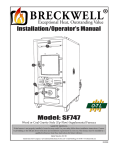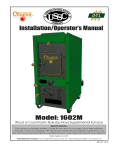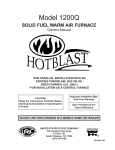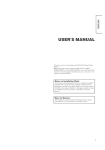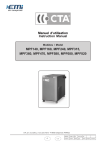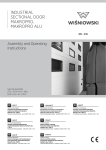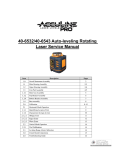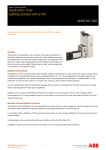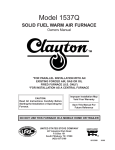Download United States Stove 1800GC Operator`s manual
Transcript
STATES STO D E T VE I N U USSC COMPANY UNITED STATES STOVE COMPANY Keeping America Warm Since 1869 MODEL: 1600GC / 1800GC CANADA ONLY THE WOOD AND COAL FURNACE SAFETY NOTICE: IF THIS FURNACE IS NOT PROPERLY INSTALLED, A HOUSE FIRE MAY RESULT. FOR YOUR SAFETY, FOLLOW THE INSTALLATION DIRECTIONS. CONTACT LOCAL BUILDING OR FIRE OFFICIALS ABOUT RESTRICTIONS AND INSTALLATION REQUIREMENTS IN YOUR AREA. Installation/Operator's Manual # 851502 TABLE OF CONTENTS Introduction ....................................................................................................... 3 Locating Your Furnace ...................................................................................... 3 Clearances ........................................................................................................ 3 Chimney Requirements ..................................................................................... 3-4 Smoke Pipe Installation ..................................................................................... 4-5 Add-on Series Installation ................................................................................. 5-7 Assembly Instructions ....................................................................................... 7-10 Wiring Diagram for Series Installation with Existing Electric Furnace ............... 11 Wiring Diagram for Series Installation with Existing Gas or Oil Furnace........... 12 Testing and Operating Procedures ................................................................... 13-14 Trouble Shooting and Problem Solving ............................................................. 15 Parts Lists Model 1600/1800 .............................................................................................. 16-17 Motorized Natural Draft ..................................................................................... 18 Installation of Optional Equiptment ................................................................... 19 2 INTRODUCTION CLEARANCES Thank you for your purchase of a U.S. Stove Woodburning furnace. Your decision to buy a Hotblast Furnace was undoubtedly reached after much careful thought and consideration. We are very proud you chose the U.S. Stove furnace and trust you will receive the comfort and economy that others realize when heating with a U.S. Stove product. Your dealer is important in your experience with the Furnace not only in your purchase, but in his recommendations for professional installation in your home. The qualified professional installer (as recommended by your dealer) has been expertly trained in solid-fuel furnace installation to assure the safety and comfort for your family while saving you money. Trust your experienced installer. He is a specialist in his field. FLAMMABLE WALL MODEL 1600 - 20"(50.8cm) MODEL 1800 - 25"(63.5cm) (TOP VIEW) MODEL 1600 - 22"(55.88cm) 1800 - 19"(48.26cm) MODEL 1600 - 12"(30.48cm) 1800 - 8"(20.32cm) IMPORTANT Before installing and using your Hotblast Furnace, please read the following pages thoroughly and carefully. If you follow the instructions, your Hotblast furnace will give you safe and more dependable service in the years to come. MODEL 1600 - 15"(38.1cm) MODEL 1800 - 18"(45.72cm) FLUE MINIMUM CLEARANCE TO FLAMMABLE WALLS CAUTION: Do not store combustible or flammable material near furnace. REDUCED CLEARANCES NFPA guidelines and most codes permit reduced clearances to combustible walls and ceilings if adequate protection is added. A common mistake is to assume that sheet metal, masonry, or asbestos board placed directly against a wall protects it. Materials installed in this manner give very little protection. These materials are good heat conductors, so they will be almost as hot on their back side as they are on the exposed side. Therefore, the combustible wall behind is still a fire hazard. A wall can be kept cool using these items but only if they're mounted and spaced out from the wall by an inch or two to allow free circulation of room air behind the protective panel. The protective panel should start within a few inches of floor level. The three rules to follow when constructing wall protectors: 1. Non-combustibility of all materials including mounting or supporting. 2. A well ventilated air space between protector or wall. 3. Sufficient strength and rigidity so that the protector and air space will be durable. ! First step; check your local codes. This installation must comply with their rulings. ! Do not install this furnace in a mobile home or trailer. ! Always have a smoke or ionization detector installed in your home. ! To prevent injury or damage, do not allow anyone who is unfamiliar with the furnace to operate it. ! Spend some time with your furnace to become well acquainted with different settings and how each will affect its burning patterns. It is impossible to state just how each setting will affect your furnace because of the variations in each installation. DISCLAIMER NOTICE The BTU ranges and heating capacity specifications are provided as a guide only and in no way guarantee the output or capacity of the units. The actual BTU output depends on the type of fuel being burned and its conditions, the thermostat setting, the draft adjustment and the chimney that the unit is hooked up to. The actual area that the unit will heat depends on factors such as the conditions of the building, heat loss, type of construction, amount of insulation, type of air movement, and the location of the unit. 2" FROM CEILING CONSTRUCTING NON-FLAMMABLE WALLS PROTECTIVE COVERING AND ALL SUPPORTS MUST BE NON-COMBUSTIBLE. 1" AIR SPACE LOCATING YOUR FURNACE 2" FROM FLOOR CHIMNEY REQUIREMENTS The furnace is to be installed maintaining clearances as shown in illustration. Do not place the furnace directly on a combustible floor. If you're placing it on a combustible floor, an approved fire retardant material equivalent to 3/8" asbestos millboard should be placed under the furnace. The material must extend at least 16" (40.64cm) in front of and 8" (20.32cm) on either side of the fuel-loading and ash-removal doors, and underneath the chimney connector and extending at least 2" (5.05cm) on either side of the chimney connector. A masonry or Class A All-Fuel Metal Insulated Chimney must be used in all airtight wood furnace installations. The minimum recommended flue size for the U.S. Stove Hotblast Furnace is 6" (15.24cm) (inside diameter) for round flues, and 7" x 7" (17.78cm) for square flues. When making new chimney installations, always follow the chimney manufacturers instructions. 3 NOTE: Type of chimney: Class A All-Fuel also referred to as Low-Heat appliance type chimney per Uniform Mechanical Code: Chimney, low-heat appliance type is a factory built, masonry or metal chimney suitable for removing the products of combustion from fuel-burning low-heat appliances producing combustion gases not in excess of 1000°F (538°C) under normal operating conditions but capable of producing com bustion gases of 1400°F (760°C) during intermittent forced firing for periods up to one hour. All temperatures are measured at the appliance flue outlet. TOP OF CHIMNEY MUST BE 2 FT. (60.96cm) ABOVE HIGHEST POINT OF ROOF 8. The portion of an all-fuel metal chimney that extends above the roof should be well secured. 9. A masonry chimney should be built on footings and not attached to the house. 10. A rain cap, complete with an animal or bird screen, should be installed on top of the chimney. CREOSOTE — FORMATION AND NEED FOR REMOVAL When wood is burned slowly, it produces tar and other organic vapors, which combine with expelled moisture to form creosote. The creosote vapors condense in the relatively cool chimney flue of a slow-burning fire. As a result, creosote residue accumulates on the flue lining. When ignited, this creosote makes an extremely hot fire. The chimney connector and chimney should be inspected at least twice monthly during the heating season to determine if a creosote build-up has occurred. If creosote has accumulated, it should be removed to reduce the risk of a chimney fire. CAP SHOULD HELP PREVENT DOWNDRAFT WHILE STILL PROVIDING ADEQUATE EXHAUST. 2 FT. (60.96cm) MINIMUM 3 FT. (91.44cm) MINIMUM RECOMMENDED MINIMAL 20 FT. (6.10m) HEIGHT MINIMAL 3 FT. (91.44cm) FROM TOP OF CHIMNEY TO POINT AT WHICH IT PASSES THROUGH THE ROOF. CHIMNEY FLUE SHOULD BE CONSTANT DIAMETER THROUGHOUT ITS ENTIRE HEIGHT. APPROVED CHIMNEY SMOKE PIPE INSTALLATION Clearances to combustible materials (i.e. paneling, ceiling tile, sheet rock, plaster, draperies, casements or wood trim, etc.) will vary with the type of flue connection used. Be sure to maintain the specified clearances for your type of installation. TYPE OF FLUE REQUIRED CONNECTION CLEARANCE 24 Gauge or Heavier 18" (45.72cm) Single Wall Stainless Steel or Black Pipe Double Wall Stainless Steel 6" (15.24cm) Model 1600 8" (20.32cm) Model 1800 CHIMNEY FLUE MUST BE AS LARGE OR LARGER THAN FURNACE FLUE PIPE Class A All-Fuel or Equivalent 2" (5.08cm) COMBUSTIBLES CLEANOUT DOOR SHOULD HAVE AIRTIGHT FIT. DO NOT LEAVE OPEN WHEN FURANCE IS IN OPERATION. SMOKE PIPE CHIMNEY THIMBLE SHOULD BE CONSTRUCTED OF FIRE CLAY, AND SHOULD FIT TIGHTLY TO FLUE PIPE. 1. The wood furnace should be the only heating appliance using a chimney flue. One furnace per flue. 2. A masonry chimney should have a tile or stainless steel liner. 3. The masonry chimney should not have any missing mortar or loose bricks. 4. There should be no mortar or parts of the chimney blocking the chimney flue. 5. There should be a two inch clearance between any chimney (masonry or metal) and combustibles (such as the house). 6. The chimney should extend at least 2' above the highest point of the house, or 2' above the point at which the chimney is 10' from the roof. 7. The chimney should be relatively straight and vertical. According to NFPA standards, single wall stove pipes can be within 9" (22.86cm) of combustibles provided an approved fire retardant material covered with 28 gauge sheet metal, spaced out 1" (2.54cm) on non-combustible spacers, is utilized. See illustration. 18" (45.72cm) 9" (22.86cm) 18" (45.72cm) CEILING OR WALL When using a Class A or double wall flue pipe connection, follow the manufacturer's instructions. 4 When constructing a single wall smoke pipe, the following guidelines must be observed. 1. The smoke pipe should be 24 gauge or heavier stain less steel or black pipe. standards allow same flue connection. Such installations can cause severe problems. Gas hoods and barometric dampers allow excess air into the chimney causing cooling of the flue gases and a greater creosote build-up potential. If the same flue connections are used, chimneys must be inspected more frequently and the chimney should be cleaned any time the creosote deposits exceed 1/4" thickness. A creosote fire in such a chimney can burn out of control because of the air leak through the barometric damper or gas hood. Keeping the chimney clean and burning well-seasoned wood is absolutely necessary. This type of installation does require more frequent inspection and maintenance. 2. Secure all joints with three #8 screws. 3. If the smoke pipe must pass through a wall, an approved insulated or ventilated thimble, at least three times the diameter of the smoke pipe must be used. (i.e. a 6" (15.24cm) diameter smoke pipe needs an 18" (45.72cm) thimble). 4. The smoke pipe should not be used as a chimney. ADD-ON SERIES INST ALLA TION INSTALLA ALLATION IMPORTANT INFORMATION FOR ALL SMOKE PIPES The smoke pipe must be constructed and installed so that it maintains clearances, keeps condensation and creosote within the pipe, and is capable of withstanding a 2000°F to 3000°F (1093°C to 1649°C) chimney fire. 1. The smoke pipe should slant down toward the furnace a minimum of 1/4" to the foot. At no time should the pipe turn downward toward the chimney or run horizontal. The downstream series techniqueis the onlyapproved method for using the 1600 and 1800 furnaces in combination with an existing gas, oil or electric forced air furnace. While it requires reworking the main duct system, it typically results in a simpler, less restrictive installation. Certification testing establishes the minimum cross-sectional area for the transfer duct permitted for a specific add-on. A large transfer duct will allow freer flow of air through the additional elbows involved in the add-on installation. 2. There should be no more than two 90 degree elbows. 3. The smoke pipe should never be longer than 6 feet.(1.83m) If it is absolutely necessary to make a run of more than six feet (not recommended) use extra support brackets every 3 feet (.91m). Additional space will be required in the furnace room for an addon. There must be a room beside the existing furnace for the addon and the transfer duct which runs from the hot air plenum of the existing furnace down to the cold air inlet of the add-on. 4. The smoke pipe should never be reduced to a smaller size than flue opening on the furnace. 5. The smoke pipe should not block the flue of the chimney or extend into it in any way. While oil, gas and electric furnaces may be connected to combustible return air ducts in the form of joist panning, wood furnaces normally require noncombustible return air duct work. Combustible return ducts connected to an existing oil, gas or electric furnace need not to be replaced with noncombustible ducts when an add-on is installed; the add-on connections make reverse flow during a power failure very unlikely. 6. A good airtight thimble should be used to hold the smoke pipe in the chimney. It should be constructed so the smoke pipe can be removed for cleaning. 7. The smoke pipe should not leave the heated portion of the building to reach the chimney. 8. The smoke pipe should not pass from one story to the next before entering the chimney, nor should it pass through any closed or enclosed space. Major changes to the main distributionduct system are normally required in order to route the existing duct over the new hot plenum of the add-on. Any indivdual ducts connected directly to registers from the existing plenum also have to be routed over to the add-on plenum because all of the air must pass through the add-on before reaching any distribution ductwork. 9. Heat reclaimers should not be installed or used in the smoke pipe. 10. The smoke pipe should not be located near or in a walk way or well traveled area. 11. All male ends of smoke pipe should run or point towards the furnace. There are two options for managing the duct alternations. In some cases, it is more practical to move the existing furnace and place the add-on in the location it previously occupied. By locating the add-on where the original furnace was, fewer supply duct alterations will be needed. On the other hand, alterations to the return ducts will be needed to re-route them to the new location of the cold air plenum. When you have installed the smoke pipe connecting your furnace to the chimney, tap the pipe hard with your fingernail. Remember the sound it makes - it will be a "ting" echoing inside the stove pipe. If later you tap and hear a muffled thud, you are building up soot in the pipe and should clean it. This pipe should be cleaned at least once or twice during the heating season. DO NOT CONNECT TWO HEATERS TO THE SAME CHIMNEY FLUE. The National Fire Prevention Association recommends that woodburning appliances vent into a separate chimney from gas or oil furnaces. If such an installation is contemplated, first check with a local building inspector to find out if a separate flue for a woodburner is required. If codes allow, use extreme care in making such installations. Be sure that one pipe is higher than the other so that the two openings will not be opposite each other. Also, when connecting two heaters into the same chimney flue, the flue size should be large enough to handle both heaters. Very few codes and The other option is to leave the existing furnace in its original location and re-route the supply ducts to the new add-on plenum. In your design of add-on installations, always choose the approach that involves using the least elbows. By keeping the number of elbows to a minimum, duct restrictions and blower noise will be reduced. 5 The connection of the add-on to an existing furnace imposes a greater work-load on the air-circulating blower. Unless compensating adjustments are made, the additional restriction will reduse air flow, and overheating of the existing furnace can result. To provide a reference point for later adjustments,you must test air flow before any installation work begins. 2. Cut an opening in the side of the Hotblast furnace that will face your existing furnace. (see illustration) There are two methods of evaluating existing air flow: the static pressure drop method and the temperature rise method. HOTBLAST FURNACE MODIFICATIONS 1. Cut and insert a piece of sheet metal of sufficient thickness to provide a tight fit over the opening on the back of the Hotblast furnace. 6" (15.24 cm) FINISHED OPENING 10" x 16" BEND BACK FLANGE 1" (2.54 cm) CUTOUT 8" H x 14" W (20.32 x 35.56 cm) 10" (25.4 cm) 16" (40.64 cm) CONNECTING HOT AIR DUCT TO FURNACE We strongly recommend that the hot airduct work be installed by a home heating specialist. If doing the installation yourself, before you decide which installation will best suit your needs, we recommend that you consult a qualified heating technician and follow his recommendations as to the most safe and efficient method of installation. 2" MIN. (5.08 cm) 1" MIN. (2.54 cm) 6' (182.88cm) 6' (182.88cm) HOT AIR PLENUM EXISTING FURNACE (if used) HOTBLAST FURNACE DUCTWORK INSTALLATION HOT AIR DUCT And Minimum MINIMUM CLEARANCES Clearances TO COMBUSTIBLES 6 1" MIN. (2.54 cm) HOT AIR PLENUM FAN LIMIT CONTROL ON PLENUM 7/8" HOLE COMBUSTION AIR 3-1/2" (8.9 cm) All fires need air (specifically oxygen) to burn. Furnaces, fireplaces, and wood-burning furnaces need enough oxygen for complete combustion of their fuels. The incomplete combustion that takes place when a furnace is "air starved" causes carbon monoxide (CO) to be formed in quantities that can be dangerous inside a well-sealed house. Having a source of combustion air from outside prevents this "air starvation" of the furnace. 6" (15.24cm) SIDE OF HOTBLAST FURNACE Drill one 7/8" hole as illustrated for placement of the Hotblast fan limit control. ASSEMBL Y INSTR UCTIONS ASSEMBLY INSTRUCTIONS Your furnace is shipped from the factory in four (3) packages. 1) the furnace, 2) fan limit kit, 3) draft kit. Before assembling the furnace, check to make sure there is no shipping damage, and that all necessary parts are located in the firebox. See parts list below. If you find shipping damage or any of the parts missing, contact the dealer immediately. He will take the necessary steps to correct the problem. DOOR HANDLE INSTALLATION Insert door handle into door. From rear side of door place 1/2" washer over threaded part of door handle. Then attach 1/2" lock nut, being careful not to over tighten. Handle should turn freely. Parts List All models include the following: Two Door Handles One Fuel Door Latch One Ash Door Latch One Shaker Grate Handle Two 1/2" Washers Six 1/4" Hex Nuts Four Lock Washers Spin Draft Five 1/4" Lock Nuts One Pivot Bracket Four Brass Coil Knobs One 1/4" x 1" Hex Bolt Three 1/2"-13 Lock Nuts One 1/2" x 2 1/2" Carriage Bolt Six 1/4" x 3/4" Hex Bolts Smoke Door Two 1/4" x 1-1/4" Carriage Bolts Two Smoke Door Clips Rod Extension FAN LIMIT KIT Fan Limit Control Fan Center F.A.D. Box 3-Speed Switch Knob FUEL & ASH DOOR LATCH INSTALLATION With two 1/4" x 3/4" hex bolts, attach the door latch to the door latch mounting bracket on the left side of door frame as illustrated. Adjust latch until door closes securely. FUEL DOOR ILLUSTRATION ASH DOOR ILLUSTRATION LOCK WASHER HEX NUTS 7 SMOKE CHAMBER: 1. Place #1 firebrick in the back of smoke chamber. 2. Slide baffle plate into smoke chamber, flat side down. 3. Place remaining firebrick in smoke chamber as numbered below. (in placing the firebrick in the smoke chamber, lift the left side of firebrick first and drop into place.) See Illustrations below. BRICK INSTALLATION (PRE-INSTALLED AT FACTORY) NOTE: Prior to operation, be sure to remove brick retaining strips. MODEL 1600 - (6) BRICKS ON EACH SIDE FIREBOX LEFT SIDE 2 MODEL 1600 (41/2) BRICKS 1 1/2 BRICK 3 5 4 BRICK RETAINING STRIP 6 SLIDE 4th BRICK BACK BEFORE INSTALLING 5th AND 6th BRICK 2 MODEL 1800 (6) FULL BRICKS MODEL 1800 - (8) BRICKS ON EACH SIDE 1 4 5 FIREBOX LEFT SIDE 6 7 BRICK RETAINING STRIP TOP FIREBOX: The firebrick must be inserted on each side resting on the grate frame. First, place cut brick in each back corner. Place remaining brick in place. REAR OF FIREBOX 8 3 ATTACHING SLIDE BAFFLE ROD EXTENSION THE MODELS 1600 AND 1800 HAVE BEEN EQUIPPED WITH DIFFERENT PLENUM OPENINGS, THEY ARE AS FOLLOWS: BAFFLE ROD EXTENSION MODEL 1600 BAFFLE ROD 13"x18" Rectangle Plenum Opening 1-1/2" HEX COUPLING MODEL 1800 18"x18" Sqaure Plenum Opening SMOKE DOOR INSTALLATION SHAKER GRATE HANDLE INSTALLATION 1. Attach angle with two 1/4" x 3/4" hex bolts and two 1/4" lock nuts. 2. Attach handle with 1/4" x 1" hex bolt and 1/4" lock nut. 3. Put brass knob onto end of handle. 1 SMOKE DOOR CLIPS 1/4" LOCK NUTS 1/4" X 1-1/4" CARRIAGE BOLTS 2 FRONT OF FURNACE SMOKE DOOR FUEL LOADING DOOR FRAME 3 9 INSTALLING ASH DOOR SPIN DRAFT MOUNTING PROCEDURE FOR MOTORIZED NATURAL DRAFT 1. Screw spin draft onto 1/2" x 2-1/2" carriage bolt. 2. Screw spin draft and bolt assembly into ash door allowing approximately 1/2" of the bolt to extend beyond the inside of the door. 3. Secure bolt in place with 1/2" locking nut. SPIN DRAFT CAP 1/2" X 2-1/2" CARRIAGE BOLT DRAFT TUBE CLAMP MOTORIZED NATURAL DRAFT 1. Using (2) 1/4" x 1" bolts, lock washers and nuts, attach draft to furnace with draft tube clamp. 2. Plug draft power cord into receptacle on front of furnace. 1/2" LOCK NUT 10 WIRING DIAGRAM FOR SERIES INSTALLATION WITH EXISTING ELECTRIC FURNACE MAIN POWER 110 VOLT BLACK TO BE ADDED WHITE BLACK BLUE FROM LIMIT BLUE HOTBLAST LIMIT CONTROL HOTBLAST COTROL CENTER MUST PULL OUT THE JUMPER BLACK BLACK BLACK TO BE ADDED ELECTRIC FURNACE THERMOSTAT RED WHITE WIRE FROM DRAFT PLUG BLACK WIRE FROM DRAFT PLUG ELECTRIC FURNACE PLUG IN ON THE FRONT OF HOTBLAST FOR DRAFT TO "W1" BLACK TO "R" ALL ELECTRICAL WIRING SHOULD BE DONE BY A QUALIFIED ELECTRICIAN. RED TO "G" NOTE: Must cut yellow end off draft wires. NOTE: DO NOT use three (3) speed switch supplied. NOTE: The jumper must be pulled out of the limit control. NOTE: Thermostat wires for the hotblast furnace go to the front of the control center attach to "R" and "G". 11 TO "R" WIRING DIAGRAM FOR SERIES INSTALLATION WITH EXISTING GAS OR OIL FURNACE SETTING LIMIT CONTROL HIGH LIMIT CONTROL LIMIT FAN 250 50 100 200 150 BLUE SAFETY STOP RH POINTER (LIMIT OPENS) 200 BLACK CENTER POINTER (FAN ON) 150 RED LH POINTER (FAN OFF) 100 WALL THERMOSTAT TO "R" ELECTRICAL BOX TO "G" BLACK DRAFT RED FAN CENTER BLACK GREEN BLACK WHITE WHITE R* TO GAS FURNACE FAN BLACK 110V POWER SUPPLY FROM GAS FURNACE Ra * OPTIONAL 120V RELAY MOUNTED IN GAS FURNACE ALL WIRING SHOULD BE DONE BY A QUALIFIED ELECTRICIAN 12 WIRE INTO GAS VALVE CIRCUIT TESTING AND OPERA TING PR OCEDURES OPERATING PROCEDURES minutes until coal fire is established before adding more coal. NOTE: NEVER load coal over the level of firebrick. ! Close by-pass damper and set all draft controls to your own needs. It may take 3 to 4 coal fires to determine how your local coal and the Hotblast Furance reacts together — adjusts drafts accordingly. ! Loading with a good bed of coals in the morning — open by-pass damper. • In normal shaking, only rock the grates a small amount to sift ash through. • Remove all ashes every day from ash pit. CAUTION: Ashes should be placed in a metal container with a tight fitting lid. The closed container of ashes should be placed on a non-combustible floor or on the ground well away from all combustible materials pending final disposal. If the ashes are disposed of by burial in soil or otherwise locally dispersed, they should be retained in the closed container until all coals have thoroughly cooled. • With your poker, push hot burning embers to the rear of the unit and add green coal in front. NEVER load over height of firebrick. This can result in damage to your furnace and home. • Close by-pass damper. ! Too much draft air will cause clinkering of coal and will waste heat up the chimney. Shut draft down to as low a point as you can and still heat your home. 1. NOTE: Never stand in front of loading door when opening it. Stand to the side. 2. NEVER completely cover the live fire with fresh coal. Always leave a generous area of burning coal at the top of the fire and at the rear. TESTING: 1. If using an optional power draft, check the draft blower by turning the room thermostat up high enough so that the draft blower turns on. Then lower the thermostat setting until you hear it shut off. 2. Use a sheet of newspaper to test your draft by placing it inside the furnace and lighting it. With completion of the tests above, you are ready to light the furnace. Follow the operating steps. STARTING A WOOD FIRE Using Motorized Natural Draft CAUTION: Never use gasoline, gasoline-type lantern fuel, kerosene, charcoal lighter fluid, or similar liquids to start or "freshen up" a fire in the furnace. Keep all such liquids well away from the furnace while it is in use. 1. Turn up thermostat to open motorized damper. 2. Open spin draft cap on ash door. 3. Pull the slide baffle rod to the front position. 4. Open the fuel load door and light fire using kindling and several sheets of newspaper, then close the furnace door. The furnace door should remain closed for 5 to 10 minutes in order to establish the fire. If the fire has established, you are ready to load the furnace. CAUTION: To prevent flame and smoke spillage, the slide baffle must be pulled out and the fuel door must be cracked for ten seconds before being fully opened. Do not over fire your furnace! After you have become familiar with its operation, you should know how much wood to use. 5. Load the furnace, close the load door and push the slide baffle rod to rear. 6. Close the spin draft cap on ash door. 7. The motorized natural draft cycles on demand from the U.S. Stove wall thermostat. Setting the thermostat four degrees higher that your existing thermostat is recommended. During operation, the motorized natural draft remains open until the thermostat temperature setting is reached. 3. Always keep the ash pit clean. !If the fire goes out or does not hold overnight, look for: 1. Poor draft. 2. Incorrect damper settings. 3. Improper firing methods for coal being used. 4. More combustion air needed. 5. Coal not sized to the furnace. We recommend 1" to 3" diameter pieces of coal. 6. Ashes, if allowed to accumulate in the ash pit, will not allow the passage of required air for combustion. Keep ash pit clean. CAUTION: To avoid excessive temperatures, do not operate with fuel door or ash pan open. 7. This furnace is not to be used with an automatic stoker unless so certified. CAUTION: To avoid excessive temperatures, do not operate with fuel door or ash pan open. OPERATING NOTES ! Do not over draft the furnace! It is designed to operate at .06 inches of water column and must be set with a draft gauge to maintain a steady draft. (Barometric Damper recommended.) STARTING A COAL FIRE If you burn coal a Forced Air Draft is required. ! Do not allow ashes to build up higher than 2" above grates. ! Open smoke pipe damper all the way. Open all draft controls on your 1600/1800. Pull the slide baffle forward. ! Place about 10-15 lbs. of coal in on the shaker grates. It should come up to about half of the first firebrick level. ! Place crumpled paper over the coal and criss-cross a couple handfuls of dry kindling wood 3/4" in thickness on top of paper. ! Ignite the paper and close loading door. Wait about 30 ! Be extremely careful when removing furnace ash pan; it can get very hot. ! With new steel, there is a small amount of oil or dirt on the metal. You may smell an odor. This is normal during the first operation. You may want to assemble the furnace out of doors and build a small fire in it to "burn off" this dirt and oil before installing the unit. 13 ! The furnace is designed to burn air dried wood and coal at a predetermined firing rate. Over firing could result in damage to the heat exchanger and cause dangerous operation. Over firing occurs when the ash door is left open during operation or a highly volatile fuel, i.e. large amounts of small kindling, is used. THIS IS A WOOD AND CO AL COAL BURNING FURNA CE AND FURNACE SHOULD NO T BE AL TERED NOT ALTERED IN ANY WAY! ! When tending the firebox always pull the baffle slide rod out prior to opening load door. Open load door slowly to avoid a "flash back". After closing load door, push the baffle slide rod to the rear. ! Equip your home with fire extinguishers and smoke detectors appropriately located. ! Oil motor on forced air draft every 90 days with a few drops of 30 wt. oil. ! Check the fit on the load door. It must fit tightly. If it does not, check for deterioration or wear of the ceramic rope seal. Replace defective seals. ! Inspect and clean your chimney and stove pipe regularly. ! In event of chimney fire, shut all draft controls and call your fire department immediately. Alert everyone in the house. If the fire is still burning vigorously, throw baking soda into firebox or discharge a fire extinguisher into the firebox. After chimney fire is over, completely inspect system for damage before further use. ! Slow fires: It is not recommended burning the U.S. Stove furnace any more than necessary early in the fall and late spring, as you cannot keep the firebox hot enough (without overheating your home) to burn gases. Slow fires can cause excessive creosote build-up in smoke pipe, chimney and firebox. ! Wood should be placed directly onto the cast iron shaker grate of the U.S. Stove furnace. Do not use additional grates and/or irons. ! In the event of a power failure, you may operate the 1600/1800 furnace provided the following instructions are followed: 1. Any air filter should be removed. 2. If the motorized natural draft is used, the draft cap is to be set at a 1/2 inch opening. If the forced air draft is used, the damper on the built-in draft regulator will automatically open to the preset factory spacing. 3. Do not burn garbage, plastics, gasoline, drain oil or other flammable liquids. Plastics, when burned, form hydrofluoric and hydrochloric acids which will damage and destroy your furnace pipe and chimney. The burning of trash or oil can result in an extremely hot fire and is sometimes a cause of chimney fires. NEVER BURN GREEN WOOD OR TIRES. ! Do not store fuel or other combustible material within marked installation clearances. NOTE: For further information on using your furnace safely, obtain a copy of the National Fire Protection Association publication "Using Coal and Wood Stoves Safely." NFPA NO. NW-81974. The address of the NFPA is 470 Atlantic Ave., Boston, Massachusetts 02210. 14 TR OUBLE SHOO TING AND PR OBLEM SOL VING TROUBLE SHOOTING PROBLEM SOLVING 1. Problem: Smoke puffs from furnace Solution: A. Check chimney draft. Check for blocked chimney or flue pipe. Use mirror to check chimney clearance. B. Check ash pit — if it is too full, empty. C. Make sure furnace room is not too airtight. D. Make sure all of chimney mortar connections are airtight. E. Check ash drawer. Make sure it's airtight. F. Check chimney for possible down-draft caused by taller surrounding trees or objects. Correct with proper chimney vent cap. G. Check the possibility of a cold chimney forcing cool gases backward. Remedied by properly insulating chimney with non-combustible liner — non-combustible insulation. H. Fuel may be too green. I. Make sure no other fuel burning devices are connected to the chimney impairing the draft. J. Check chimney draft, it should be .06 inches of water column. D. Check chimney draft — make sure chimney flue pipe is clean and chimney is of adequate height. E. Make sure you're not suffocating the fire with excessive amounts of unburned wood. F. Slide baffle should be pulled out prior to load door opening. 4. Problem: 4.Problem: Distribution blower vibrating Solution: A. Tighten blower wheel to motor shaft. B. Check for bad fan bearings. 5. Problem: Distribution blower continues to run or will not run Solution: A. Check fan limit or heat sensor and cable. B. Check to see that blower is properly wired. (See Wiring and Assembly Instructions). C. Check fuse box or power source. D. Check power supply. 6. Problem: Draft blower continues to run or will not run Solution: A. Check wiring. B. Check thermostat or thermostat wire for short. C. Make sure temperature is calling for heat. 2. Problem: Inadequate heat being delivered to your home Solution: A. Check home insulation — is it adequate? B. Check hook-up to furnace — is it installed correctly? C. Cool air inlet may be inadequate or furnace room too airtight. D. Your wood fuel may be too low grade. Hardwoods are recommended. E. Make sure your hot air duct (and other duct work) is airtight. F. If furnace room is warm but your home isn't, check back draft dampers. G. Is air to the blower available? 7. Problem: Odor from first fire Solution: A. The odor from new steel should disappear in a few hours. B. If the odor remains, call you dealer immediately. A bad weld can cause a fume leak. 8. Problem: Excessive Creosote Solution: A. Check the grade of wood you are burning. B. Make sure your unit is serviced by its own proper chimney. C. Check length of flue pipe and its connections. D. Make sure you are burning the smallest, hottest fire to adequately heat your home. E. Also see Solutions to Problem one. 3. Problem: Excess smoke or flames coming out door when refueling Solution: A. Wait 15 seconds and open door SLOWLY — then refuel. B. Check length of flue pipe to chimney. Your unit should be within six (6) feet of your chimney. C. Make sure chimney cap is not too close to the top of the chimney. 15 PAR TS LIST ARTS MODEL 1600/1800 43 45 33 42 27 34 26 32 33 31 44 29 50 37 28 30 35 40 38 36 39 50 47 46 49 48 ITEM 26 27 28 29 30 31 32 33 34 35 36 37 38 DESCRIPTION Top Safety Latch Feed Door (Drilled) Ash Door (Drilled) Door Latch Handle Ash Door Latch 1/2" Flat Washer 1/2" Lock Nut 5/16" x 1" Hinge Pin 1/2" Rope for Fire Door 52" 1/2" Rope for Ash Door 32" Aqua-Siphon Cover Shaker Grate Handle Hinge Bracket PART# 23786 69091 68880 24179(2) 23823 83835(2) 83444(3) C21399(4) 88057 88057 23819 C000177 24204 ITEM 39 40 41 42 43 44 45 46 47 48 49 50 16 DESCRIPTION 1/4" x 3/4" Hex Bolt 1/-20 Kep Nuts 1/4" x 1" Hex Bolt 1/4" x 1-1/4" Carriage Bolt 1/4-20 Kep Nut Smoke Door Curtain Smoke Door Clip 1/2" x 1-1/2" Hex Connector Baffle Rod Extension 1/2" Hex Nut 1/2" Coupling Brass Coil Knob Feed Door Assembled Ash Door Assembled 40 41 PART# 83339(6) 83250(8) 83379 83445(2) 83250(2) 23800 23787(2) C21899 C000089 83276(2) C21899 89574(4) 68829 68880 PAR TS LIST ARTS 15 3 16 19 6 MODEL 1600/1800 13 17 4 1 11 12 22 9 18 10 8 24 7 21 20 ITEM 1 DESCRIPTION Left Side Front Assy. 2 Right Side Front Assy. 3 Top Wrapper 4 Back Weldment 5 6 Side Insulation (2ea.) Back Insulation 7 Ash Pan Weldment 8 9 Carrying Handle Shaker Grate Section 10 Shaker Bar * Snap in Receptacle MODEL 1600 1800 1600 1800 1600 1800 1600 1800 1600 1800 1600 1800 1600 1800 1800 1600 1800 1600 1800 BOTH 23 5 14 PART# 68821 68962 68822 68961 69088 68964 68823 68963 C98771 23977 C98971 23978(2) 68882 68919 24233 23852 68914 C000047 23961 80351 * = NOT SHOWN 17 NOTE: 1600 = 16 - FULL BRICK 1- HALF BRICK 1800 = 22 - FULL BRICK 2 ITEM 11 12 13 14 DESCRIPTION Full Brick Full Brick Slide Baffle Plate Grate Retainer 15 Baffle Rod S/S 16 Top Insulation 17 Front Filler 18 Draft Cover 19 Top Flue Ring 20 21 22 Draft Cap 1/2" x 2-1/2" Bolt Back Liner 23 Front Liner 24 Cabinet Side Back MODEL BOTH 1600 BOTH 1600 1800 1600 1800 1600 1800 1600 1800 1600 1800 1600 1800 BOTH BOTH 1600 1800 1600 1800 1800 PART# 89066 23887 24231 40312(2) 40337(2) C10871 89704 C98871 23979(2) 23817 24190 23818 24508 22761 23958 23859 C20599 40313 40339 40344 40338 69002 MO TORIZED NA TURAL DRAFT P AR TS LIST MOT NATURAL PAR ARTS PRE-ASSEMBLED AT FACTORY (OPTIONAL KIT) 6 7 5 1 12 11 2 2 10 9 8 11 3 MODEL 1600 / 1800 4 3 ITEM DESCRIPTION 1 Draw Band 4 MODEL 1600/1800 MND KIT #C60357M 2 3 4 5 6 1/4" x 1" Bolt 1/4" Lock Washer 1/4" Hex Nut Erie Motor-120v Draft Cap 83379 83414 83072 C45099 23859 7 Draft Tube Weldment 68872 8 Flipper Tube 23899 9 Flipper 23898 1/2" - 13 Hex Lock Nut #8 x 1/2" Tek Screw 1/2 x 2-1/2 Carriage Bolt Thermostat 83444 83455 C20599 80129 10 11 12 * 18 PART# 23888 INST ALLA TION OF OPTIONAL EQ UIPMENT INSTALLA ALLATION EQUIPMENT INSTALLING DOMESTIC HOT WATER COIL 1. Remove access panel at rear of enclosure. 2. With a utility knife cut out the section of fiberglass insulation directly behind the access panel. 3. Remove cover plate from rear of firebox. 4. Place one nut on each end of the coil and thread each as far as they will go. 5. Place the coil through the holes from the inside of the firebox and run a washer and nut down each leg on the outside of the stove. Before tightening the nuts down completely, wrap a piece of hi-temp fiberglass rope gasket, provided with the kit, around each threaded leg between the washer and the outisde of the firebox. Tighten the nuts down securely to insure an airtight installation. The installation is now ready to be plumbed to your existing domestic hot water system. Choose one of the three methods described in the Hot Water Kit Installation Instructions. 6. Remove knockouts from access panel and attach to furnace enclosure. 7. Have a qualified plumber connect your domestic hot water pipe to the coil with appropriate fittings. 2 ACCESS PANEL 1 3 4 REAR WALL OF FIREBOX 5 DOMESTIC HOT WATER COIL 1. NUT 2. WASHER 3. GASKET 19 TURN INSIDE NUTS UP TO END OF THREADS 6 HO W TO ORDER REP AIR P AR TS HOW REPAIR PAR ARTS THIS MANUAL WILL HELP YOU OBTAIN EFFICIENT, DEPENDABLE SERVICE FROM THE HEATER, AND ENABLE YOU TO ORDER REPAIR PARTS CORRECTLY. KEEP IN A SAFE PLACE FOR FUTURE REFERENCE. WHEN WRITING, ALWAYS GIVE THE FULL MODEL NUMBER WHICH IS ON THE NAMEPLATE ATTACHED TO THE BACK OF THE HEATER. WHEN ORDERING REPAIR PARTS, ALWAYS GIVE THE FOLLOWING INFORMATION AS SHOWN IN THIS LIST: 1. The 2. The 3. The 4. The PART NUMBER PART DESCRIPTION MODEL NUMBER: 1600GC / 1800GC SERIAL NUMBER: ____________________ UNITED STATES STOVE COMPANY 227 Industrial Park Road P.O. Box 151 South Pittsburg, TN 37380 (423) 837-2100























